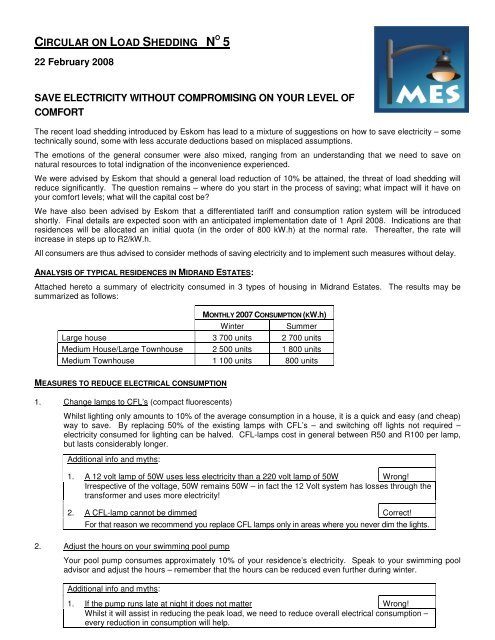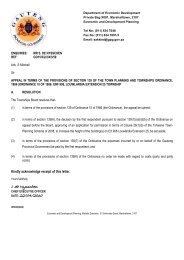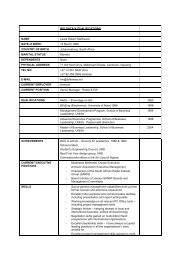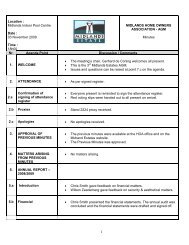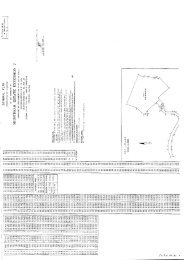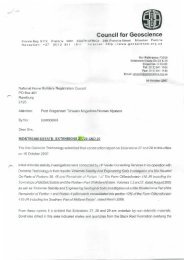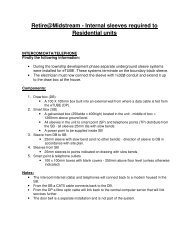How to save electricity - Midrand Estates
How to save electricity - Midrand Estates
How to save electricity - Midrand Estates
You also want an ePaper? Increase the reach of your titles
YUMPU automatically turns print PDFs into web optimized ePapers that Google loves.
CIRCULAR ON LOAD SHEDDING N O 5<br />
22 February 2008<br />
SAVE ELECTRICITY WITHOUT COMPROMISING ON YOUR LEVEL OF<br />
COMFORT<br />
The recent load shedding introduced by Eskom has lead <strong>to</strong> a mixture of suggestions on how <strong>to</strong> <strong>save</strong> <strong>electricity</strong> – some<br />
technically sound, some with less accurate deductions based on misplaced assumptions.<br />
The emotions of the general consumer were also mixed, ranging from an understanding that we need <strong>to</strong> <strong>save</strong> on<br />
natural resources <strong>to</strong> <strong>to</strong>tal indignation of the inconvenience experienced.<br />
We were advised by Eskom that should a general load reduction of 10% be attained, the threat of load shedding will<br />
reduce significantly. The question remains – where do you start in the process of saving; what impact will it have on<br />
your comfort levels; what will the capital cost be<br />
We have also been advised by Eskom that a differentiated tariff and consumption ration system will be introduced<br />
shortly. Final details are expected soon with an anticipated implementation date of 1 April 2008. Indications are that<br />
residences will be allocated an initial quota (in the order of 800 kW.h) at the normal rate. Thereafter, the rate will<br />
increase in steps up <strong>to</strong> R2/kW.h.<br />
All consumers are thus advised <strong>to</strong> consider methods of saving <strong>electricity</strong> and <strong>to</strong> implement such measures without delay.<br />
ANALYSIS OF TYPICAL RESIDENCES IN MIDRAND ESTATES:<br />
Attached here<strong>to</strong> a summary of <strong>electricity</strong> consumed in 3 types of housing in <strong>Midrand</strong> <strong>Estates</strong>. The results may be<br />
summarized as follows:<br />
MONTHLY 2007 CONSUMPTION (KW.h)<br />
Winter Summer<br />
Large house 3 700 units 2 700 units<br />
Medium House/Large Townhouse 2 500 units 1 800 units<br />
Medium Townhouse 1 100 units 800 units<br />
MEASURES TO REDUCE ELECTRICAL CONSUMPTION<br />
1. Change lamps <strong>to</strong> CFL’s (compact fluorescents)<br />
Whilst lighting only amounts <strong>to</strong> 10% of the average consumption in a house, it is a quick and easy (and cheap)<br />
way <strong>to</strong> <strong>save</strong>. By replacing 50% of the existing lamps with CFL’s – and switching off lights not required –<br />
<strong>electricity</strong> consumed for lighting can be halved. CFL-lamps cost in general between R50 and R100 per lamp,<br />
but lasts considerably longer.<br />
Additional info and myths:<br />
1. A 12 volt lamp of 50W uses less <strong>electricity</strong> than a 220 volt lamp of 50W Wrong!<br />
Irrespective of the voltage, 50W remains 50W – in fact the 12 Volt system has losses through the<br />
transformer and uses more <strong>electricity</strong>!<br />
2. A CFL-lamp cannot be dimmed Correct!<br />
For that reason we recommend you replace CFL lamps only in areas where you never dim the lights.<br />
2. Adjust the hours on your swimming pool pump<br />
Your pool pump consumes approximately 10% of your residence’s <strong>electricity</strong>. Speak <strong>to</strong> your swimming pool<br />
advisor and adjust the hours – remember that the hours can be reduced even further during winter.<br />
Additional info and myths:<br />
1. If the pump runs late at night it does not matter Wrong!<br />
Whilst it will assist in reducing the peak load, we need <strong>to</strong> reduce overall electrical consumption –<br />
every reduction in consumption will help.
2<br />
3. Switch off the under floor heaters when not required<br />
Space heaters and under floor heaters consumes between 25% and 40% of the <strong>electricity</strong> in a household<br />
during the winter months. Whilst most people will switch their space heaters off when leaving a room for a<br />
prolonged period, under floor heaters are not switched off as it is difficult <strong>to</strong> reach them. MES has assisted in<br />
the development of Programmable under floor heater thermostat (PUHT) and will subsidise the sale of the<br />
units. Cost of the unit (including installation) will be approximately R650 each. The <strong>electricity</strong> ‘<strong>save</strong>d’ in winter<br />
months per unit will be in the order of 100 kW.h units – approximately R50/month @ 50c per kW.h or<br />
R200/month @ R2/kW.h.<br />
4. Geysers with water pre-heated by solar radiation<br />
SUMMARY:<br />
The heating of water consumes between 20% and 25% of a house’s electrical consumption the whole year! It<br />
is recommended that solar vacuum tubes be installed and be coupled <strong>to</strong> the existing geyser. Such an<br />
installation will use the sunlight <strong>to</strong> pre-heat the inflow of water <strong>to</strong> the geyser with a circulating pump being used<br />
<strong>to</strong> draw colder water from the geyser and pass it through the solar heat exchange unit. The benefit of using<br />
the existing geyser lies in the availability of the heating element <strong>to</strong> heat the drawn down geyser during night<br />
time in preparation for an early morning shower.<br />
The solar system compatible with a 200 litre geyser will cost between R8 000 and R12 000 installed and<br />
should ‘<strong>save</strong>’ 100 kW.h units per month for 12 months of the year.<br />
Additional info and myths:<br />
1. I can <strong>save</strong> R500 worth of <strong>electricity</strong> per month by installing a timer switch on my<br />
geyser (or switching the geyser off during the day)<br />
Wrong!<br />
The cost involved in raising the temperature of 200 litre water from 10 ºC <strong>to</strong> 60 ºC is approximately<br />
R3. This will equate <strong>to</strong> R90 per month for a 200 litre geyser – it is thus impossible <strong>to</strong> <strong>save</strong> R500.<br />
You can, however, <strong>save</strong> 10 – 20 units (R10) per month by switching off your geyser during daytime –<br />
this will not apply if you have a solar heated geyser.<br />
2. <strong>How</strong> can I <strong>save</strong> further Information<br />
Limit heat loss from your geyser. Once heated, your geyser will ‘loose’ heat due <strong>to</strong> the temperature<br />
gradient. There are three ways in which the heat loss can be limited:<br />
i) Lower the setting on your geyser <strong>to</strong> 60 ºC;<br />
ii) Install a geyser blanket <strong>to</strong> improve insulation of your geyser – cost of the blanket is R150 -<br />
expect <strong>to</strong> <strong>save</strong> 10 <strong>to</strong> 20 kW.h units per month;<br />
iii) Do not install the geyser outdoors on a concrete slab exposed <strong>to</strong> the elements – the ambient<br />
temperature may be up <strong>to</strong> 15 degrees lower during winter than a geyser installed in a roof<br />
void, leading <strong>to</strong> an increased heat loss.<br />
South African residents are challenged <strong>to</strong> <strong>save</strong> <strong>electricity</strong> where possible <strong>to</strong> alleviate the demand of <strong>electricity</strong> and<br />
reduce our carbon footprint.<br />
A five point plan is proposed <strong>to</strong> <strong>save</strong> <strong>electricity</strong> in any residence, namely:<br />
1. Change 50% of the internal lamps <strong>to</strong> CFL’s;<br />
2. Change 100% of the external lamps <strong>to</strong> CFL’s;<br />
3. Reduce the number of hours the pool pump mo<strong>to</strong>r runs;<br />
4. Install solar vacuum tubes <strong>to</strong> heat the geyser for the evening cycle – retain the normal element for the<br />
early morning cycle;<br />
5. Reduce the number of hours the under floor heater remains switched on during winter.<br />
The adjusted consumption figures may be as follows:<br />
MONTHLY CONSUMPTION (KW.h)<br />
(BEFORE AND AFTER SAVINGS)<br />
Winter<br />
Summer<br />
Before After Before After<br />
Large house 3730 units 2510 units 2710 units 2180 units (a saving of 25%)<br />
Medium House/Large Townhouse 2450 units 1720 units 1770 units 1440 units (a saving of 25%)<br />
Medium Townhouse 1090 units 910 units 750 units 620 units (a saving of 17%)


